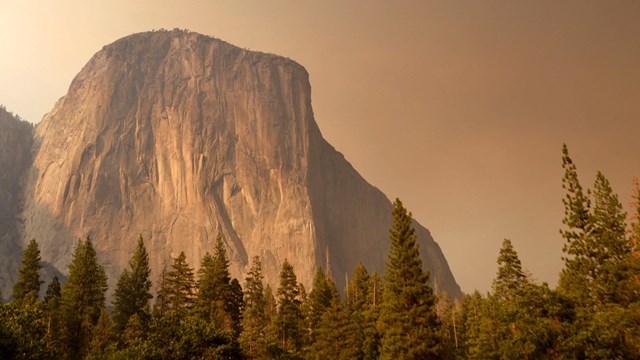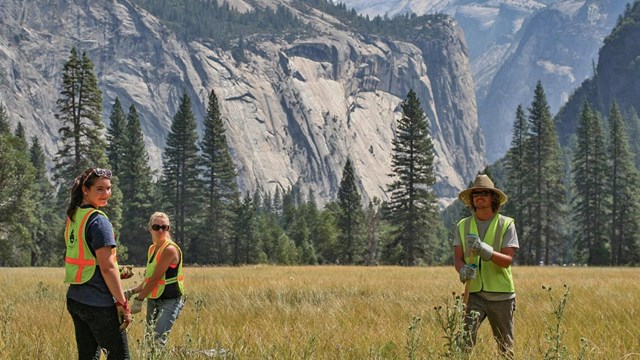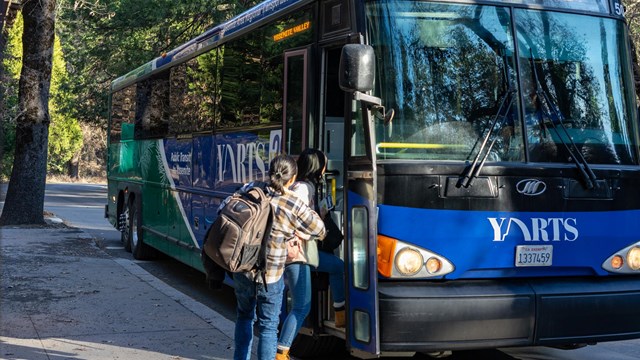
“Traffic, deadlines, health, car trouble…” What things in life causes you stress? For trees in Yosemite, that list might look more like “Water, bugs, disease, and my 100 closest neighbors.” California lost 142 million trees between 2012 and 2018 due to the combined impacts of many different stress factors, compounded by climate change. Forest health is particularly significant because growing vegetation serves the crucial role of removing carbon from the atmosphere and storing it in living ecosystems. Rising rates of tree death across the western US decrease the capacity of forests to store carbon, increasing the magnitude of global climate change. A Domino EffectWhen European settlers arrived in Yosemite in the 1850s, they began a policy of suppressing natural fires that had previously burned regularly on the landscape. They also ended the periodic burning of Yosemite Valley that had been conducted for hundreds of years by Yosemite’s first people. Without fire to thin the forest and open the canopy, forests became denser and more crowded. Today, fire is seen as essential for forest health and park fire managers use both natural and prescribed burns to help restore historic conditions. However, many areas of high-density forest remain, increasing competition for limited soil moisture during periods of drought. 
Left: Forest burned in a prescribed burn in 1978 and by wildfire in 1996. (2007 photo). Right: Forest unburned since 1936 (2008 photo). Figure from Lutz et al., 2009. Drought in California is caused by complex long- and short-term climate processes that block winter storms from reaching the state, lowering winter precipitation and Sierra Nevada snowpack. Tree ring studies show that California has experienced repeated cycles of natural drought going back over a thousand years; recent significant droughts took place in 1929–34, 1976–77, 1987–92, and 2007–09. In 2012–16, record-high temperatures combined with dry conditions to create the most intense drought in centuries. Scientists refer to this event as a “hotter drought,” where unusually high temperatures magnify the threat to forests by increasing evapotranspiration (evaporation from the ground and from plant leaves), resulting in even less water availability. Like dehydrated people, drought-stressed trees can develop other health problems. Bark beetles take advantage of drought to burrow into the living phloem (inner bark) without being ejected by pitch, the tree’s first line of defense. After invading, beetles carve galleries and lay eggs which hatch into larvae and continue to chew through the phloem, choking off the tree’s circulation. Pines in Yosemite are vulnerable to several different pine beetles (Dendroctonus spp.), which also transmit fungal spores that infect the trunk. Red and white fir trees can be attacked by fir engraver beetles (Scolytus spp.), while incense cedars host at least six different cedar bark beetles (Phloeosinus spp.). Like the final dominoes in a long cascade, these beetles (along with many other insects and fungal pathogens) can be the final cause of death for overcrowded, dehydrated trees. But this domino effect isn’t always straightforward. Although all of these beetles are native to the Sierra Nevada, climate change is likely to affect their populations and phenology (biological timing) in ways that vary from species to species. During outbreaks when insect numbers are high enough, even healthy trees may be killed. At the same time, warming temperatures alone can create chronic stress on trees, making the effects of drought, insect attack, and fungal disease more severe. Across the western US, the rate of tree mortality doubled between 1955 and 2007. Scientists identify the underlying cause as higher temperatures and water deficits associated with human-caused climate change. But how can we use the past to understand the future of Yosemite’s forests? Like forensic scientists at a crime scene, biologists use many different tools to determine the what, where, when, and why of tree death. 
Left: A photo taken during an aerial survey in 2018 shows mortality in mixed-conifer forest in near Yosemite West (USFS photo). Right: A research team surveys a plot, gathering data on forest health over time (USGS photo). When a tree falls in the forest...Forests are vast ecosystems, difficult to understand fully from ground level. Every year, the US Forest Service use small planes to conduct aerial surveys, measuring the extent of mortality for different tree species throughout much of California (including Yosemite). In addition to documenting the what and where of tree death, scientists work to discover the when and why. Some forest plots in Yosemite have been studied continuously since the early 1990s, with researchers visiting every year to track the number and species of living and dead trees. These studies provide a real-time record of conditions that lead to death and new life in a forest. But how do you figure out what killed a tree, decades after the tree’s death? Using tree rings to determine the year of death paired with historical data on drought severity and snowpack levels, scientists can look back into a forest’s past (see chart below). Like forests themselves, the study of forest health is large-scale and long-term—just a handful of trees or a few years of observation can’t tell the whole story. Fire or insect outbreak can devastate some patches of forest while leaving others untouched; a single wet year can be followed by a longer drought. Large-scale studies that combine data from across the western US over many decades provide important context as we work to understand how changes seen in Yosemite’s forests. 
What changes are we seeing?
What’s next?

Right: Beetle galleries are visible on the limb of a sequoia. Threats to Yosemite's SequoiasGiant sequoias are famously long-lived trees, with many “monarchs” reaching 2,000 years of age or more. Scientists have long believed them resistant to low-intensity fire, drought, and insect attack; in the past, the main cause of death in sequoia groves was high winds, bringing the shallow-rooted giants crashing to the ground. However, over 2014–19 (during and after the historic drought of 2012–16), Sequoia and Kings Canyon National Parks lost 28 standing monarchs to beetle infestation. Several sequoias in Yosemite’s Mariposa Grove also died. These unexpected losses have prompted concern about the future of the big trees as hotter droughts become more common; experts fear that more large sequoias could be lost in coming years. Carbon StorehousesWhat is a forest worth? Apart from its value to human visitors and local ecosystems, trees play a critical role in sequestering (storing) carbon that would otherwise enter the atmosphere as a greenhouse gas. As plants grow, die, decompose, and are burned in fires, carbon cycles in and out of the atmosphere. According to a 2015 study, at any given time vegetation in Yosemite stores around 550,000 metric tons of carbon—roughly equivalent to the annual emissions of 2.6 million Americans. However, Yosemite’s carbon storage capacity has fallen in recent years largely due to vegetation lost in large wildfires, and researchers project the park’s capacity to drop to 351,000 metric tons by 2050. Increasing wildfire and slower vegetation growth rates across the western US raise the possibility that western forests could transform from carbon “sinks” to carbon “sources”—producing more carbon than they absorb. Rising atmospheric carbon, in turn, may increase forest mortality and fire activity, further decreasing carbon storage capacity in a feedback cascade with long-term impacts. 
Climate Change in Yosemite
What does it mean to conserve and protect a place during a time of large-scale environmental change? 
How is the park responding?
Yosemite serves as a unique living laboratory for climate scientists and a center for teaching, learning, and connection. 
What can we do?
Simple choices can change the environmental impact of your trip to Yosemite. How can we shrink the carbon footprint we leave behind?
Learn More
|
Last updated: May 5, 2025
